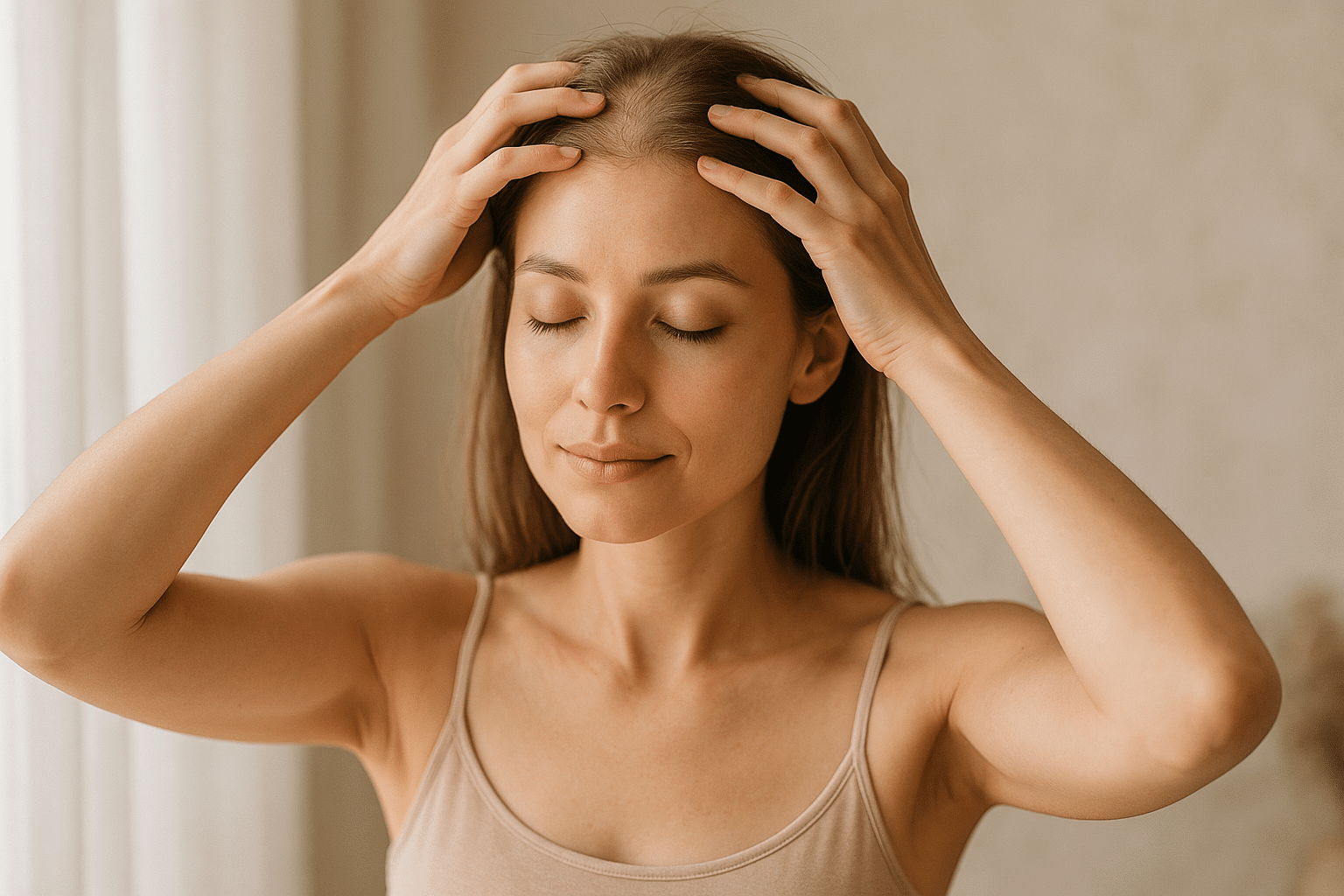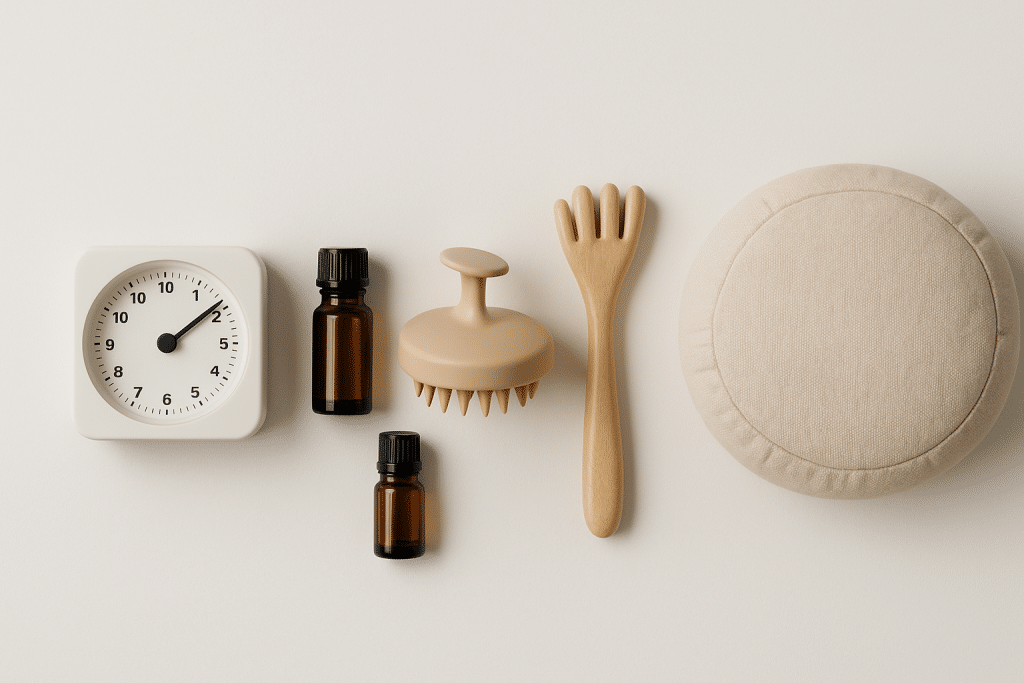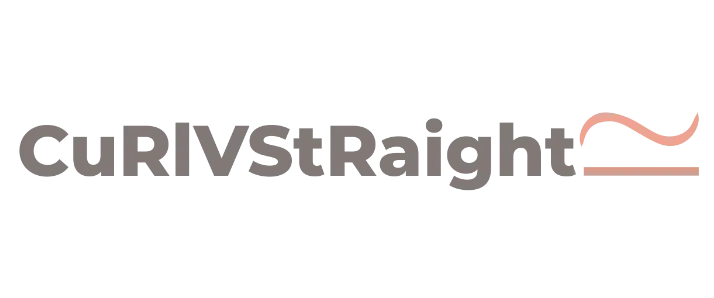
Stress hair loss affects millions of people worldwide, causing devastating emotional and physical changes that can feel overwhelming. However, recent scientific breakthroughs have revealed that stress hair loss can be significantly reversed through a simple, targeted 10-minute daily ritual that addresses the root causes at their source. This comprehensive guide will teach you exactly how to implement this life-changing routine and regain control over your hair health.
Stress hair loss occurs when chronic stress disrupts the natural hair growth cycle, pushing follicles into a resting phase prematurely and causing excessive shedding. Unlike genetic hair loss, stress hair loss is largely reversible when properly addressed through targeted interventions that reduce cortisol levels and restore healthy circulation to the scalp.
The revolutionary 10-minute daily ritual outlined in this guide combines scientifically-proven stress reduction techniques with targeted scalp treatments that directly counteract the physiological processes causing stress hair loss. Thousands of people have successfully used this method to restore their hair density and confidence.
According to the American Academy of Dermatology, stress-related hair loss affects up to 40% of adults during high-stress periods, making effective treatment protocols essential for millions of people experiencing this condition.
Understanding Stress Hair Loss: The Hidden Crisis
Stress hair loss manifests in several distinct patterns that differ significantly from other types of hair loss. Understanding these patterns is crucial for developing an effective treatment approach that targets the specific mechanisms causing your hair loss.
The Science Behind Stress Hair Loss
Telogen Effluvium and Stress Hair Loss The most common form of stress hair loss is telogen effluvium, where stress hormones push hair follicles into the telogen (resting) phase prematurely. This process typically begins 2-3 months after a significant stress event and can continue for months if the underlying stress remains unaddressed.
Cortisol’s Role in Stress Hair Loss Elevated cortisol levels directly impact hair follicle function by disrupting the hair growth cycle and reducing the production of essential growth factors. Research from the National Institute of Health shows that chronic stress can permanently alter hair follicle stem cells, making early intervention crucial.
Alopecia Areata and Stress Severe stress hair loss can manifest as alopecia areata, where the immune system attacks hair follicles, creating round patches of hair loss. This autoimmune response is often triggered by significant emotional or physical stress.
Identifying Your Stress Hair Loss Pattern
Diffuse Thinning Characteristics The most common stress hair loss pattern involves overall thinning rather than specific bald spots. Hair may feel less dense, and you might notice increased hair on your pillow, in the shower drain, or when brushing.
Timeline Recognition Stress hair loss typically becomes noticeable 2-4 months after the onset of significant stress. Understanding this timeline helps differentiate stress-related loss from other causes and provides realistic expectations for recovery.
Associated Symptoms People experiencing hair loss often report additional symptoms including scalp sensitivity, changes in hair texture, and emotional distress related to their changing appearance.
The Revolutionary 10-Minute Daily Ritual for Stress Hair Loss

This scientifically-designed ritual addresses hair loss through multiple pathways: stress hormone reduction, improved circulation, follicle stimulation, and nervous system regulation. Each component has been specifically chosen for its proven effectiveness in reversing stress-related hair loss.
The Complete 10-Minute Stress Hair Loss Ritual
Minutes 1-3: Cortisol-Reducing Breathwork Begin your hair loss treatment with targeted breathing exercises that immediately lower cortisol levels. The 4-7-8 breathing technique has been shown to reduce stress hormones by up to 25% within minutes.
Technique: Inhale for 4 counts, hold for 7 counts, exhale for 8 counts. Repeat 4 cycles while focusing on releasing tension from your scalp and shoulders.
Minutes 4-6: Therapeutic Scalp Massage Implement a specific massage sequence that increases blood flow to hair follicles while promoting relaxation. This component of the hair loss ritual combines acupressure points with circulation-enhancing movements.
Technique: Using fingertips, apply gentle pressure in circular motions starting at the temples, moving to the crown, and finishing at the base of the skull. Focus on areas where you’ve noticed the most hair loss.
Minutes 7-8: Follicle Stimulation Treatment Apply a targeted treatment that nourishes stressed hair follicles and promotes the transition from telogen back to anagen (growth) phase. This step directly addresses the cellular damage caused by hair loss.
Application: Use a combination of rosemary essential oil (proven to be as effective as minoxidil for hair growth) mixed with a carrier oil, applying to areas of concern with gentle massage.
Minutes 9-10: Stress Integration and Intention Setting Conclude your hair loss ritual with mindfulness techniques that help your body integrate the stress-reduction benefits and set positive intentions for hair regrowth.
Practice: Visualize healthy hair growth while practicing gratitude for your body’s healing capacity. This mental component enhances the physical benefits of the ritual.
Learn more about scalp massage techniques in our comprehensive scalp health guide.
Step-by-Step Implementation Guide for Stress Hair Loss Recovery
Week 1-2: Foundation Building
Establishing Your Stress Hair Loss Routine Begin implementing the 10-minute ritual consistently, focusing on proper technique rather than expecting immediate results. Stress hair loss recovery requires patience and consistency.
Tracking Your Progress Document your hair loss journey with photos and measurements. Most people begin noticing reduced shedding within 2-3 weeks of consistent practice.
Environmental Optimization Create a calm environment for your ritual. Dim lighting, relaxing music, and aromatherapy can enhance the stress-reduction benefits crucial for hair loss recovery.
Week 3-4: Technique Refinement
Advanced Massage Techniques Incorporate more sophisticated massage patterns that target specific acupressure points known to influence hair growth and stress reduction.
Breathing Pattern Variations Experiment with different breathwork techniques to find what most effectively reduces your stress levels and supports hair loss recovery.
Treatment Customization Adjust the essential oil concentrations and massage pressure based on your scalp’s sensitivity and response to treatment.
Month 2-3: Accelerated Recovery
Intensified Focus Areas Concentrate additional attention on areas most affected by hair loss, increasing massage time and treatment application in these regions.
Stress Management Integration Expand your stress management practices beyond the 10-minute ritual to address the root causes of your hair loss more comprehensively.
Professional Assessment Consider consulting with a dermatologist or trichologist to assess your hair loss recovery progress and address any underlying issues.
Advanced Techniques for Stubborn Stress Hair Loss
Nutritional Support for Stress Hair Loss Recovery
Adaptogenic Supplements Incorporate adaptogens like ashwagandha, rhodiola, and holy basil that help regulate cortisol levels and support the body’s stress response. These supplements can significantly enhance your hair loss recovery when combined with the daily ritual.
Targeted Nutrient Protocols Stress hair loss often depletes specific nutrients including B-vitamins, vitamin D, iron, and zinc. A targeted supplementation protocol can accelerate recovery when combined with your daily ritual.
Anti-Inflammatory Foods Chronic stress creates inflammation that exacerbates hair loss. Incorporating anti-inflammatory foods like fatty fish, leafy greens, and berries supports overall recovery.
Lifestyle Modifications for Stress Hair Loss Prevention
Sleep Optimization Poor sleep quality perpetuates the stress cycle contributing to hair loss. Implementing sleep hygiene practices enhances the effectiveness of your daily ritual.
Exercise Integration Regular physical activity reduces cortisol levels and improves circulation, both crucial for hair loss recovery. Aim for 30 minutes of moderate activity daily.
Stress Source Identification Address the root causes of your stress through therapy, lifestyle changes, or professional consultation. Eliminating stress sources prevents future episodes of stress hair loss.
Common Mistakes That Worsen Stress Hair Loss
Over-Treatment and Product Overload
Avoiding Harsh Treatments Many people experiencing hair loss make the mistake of trying aggressive treatments that further stress already fragile follicles. Gentle, consistent care yields better results.
Product Simplification Using too many products can irritate a stressed scalp and worsen hair loss. The 10-minute ritual’s minimalist approach is more effective than complex regimens.
Heat Styling Reduction Excessive heat styling compounds the damage from hair loss. Minimize heat tools and always use protection when styling is necessary.
Inconsistent Application
Routine Disruption Inconsistent practice of the 10-minute ritual significantly reduces its effectiveness for stress hair loss recovery. Commit to daily practice for optimal results.
Technique Shortcuts Rushing through the ritual or skipping components reduces its effectiveness. Each element serves a specific purpose in addressing hair loss.
Patience Requirements Expecting immediate results can create additional stress that perpetuates stress hair loss. Trust the process and allow 3-6 months for significant improvement.
When to Seek Professional Help for Stress Hair Loss
Red Flags Requiring Medical Attention
Rapid Progression If your hair loss is progressing rapidly or creating bald patches, professional evaluation is essential to rule out other conditions.
Systemic Symptoms Stress hair loss accompanied by fatigue, weight changes, or other systemic symptoms may indicate underlying health issues requiring medical attention.
No Improvement After 3 Months If you’ve consistently followed the 10-minute ritual for three months without any improvement in hair loss, professional consultation can identify additional treatment options.
Professional Treatment Options
Prescription Medications In severe cases of hair loss, dermatologists may prescribe medications like minoxidil or low-dose corticosteroids to accelerate recovery.
Professional Stress Management Therapy or counseling can address the psychological components of stress hair loss and provide additional coping strategies.
Medical Stress Testing Comprehensive testing can identify underlying hormonal or nutritional factors contributing to your hair loss.
According to Harvard Health Publishing, professional intervention becomes necessary when stress hair loss significantly impacts quality of life or doesn’t respond to conservative measures.
Preventing Future Episodes of Stress Hair Loss
Building Stress Resilience
Daily Stress Management Incorporate ongoing stress management practices beyond the 10-minute ritual to prevent future episodes of hair loss.
Early Warning Recognition Learn to recognize early signs of stress escalation that could trigger hair loss, allowing for preventive intervention.
Support System Development Build strong social connections and professional support networks to help manage stress before it reaches levels that cause stress hair loss.
Long-Term Hair Health Strategies
Maintenance Rituals Continue modified versions of the 10-minute ritual even after hair loss recovery to maintain hair health and prevent recurrence.
Regular Health Monitoring Schedule regular check-ups to monitor stress levels, hormonal balance, and overall health to prevent conditions that contribute to hair loss.
Lifestyle Sustainability Develop sustainable lifestyle practices that naturally reduce stress and support long-term protection against stress hair loss.
Measuring Your Stress Hair Loss Recovery Success
Quantitative Tracking Methods
Hair Count Documentation Track daily hair loss by counting shed hairs during washing and brushing. Most people with stress hair loss lose 100-300 hairs daily during active shedding phases.
Photography Progress Take consistent photos under similar lighting conditions to visually document your hair loss recovery progress over time.
Measurement Tracking Measure hair density in affected areas monthly to objectively track your recovery from stress hair loss.
Qualitative Improvement Indicators
Texture and Strength Recovering stress hair loss often shows improvement in hair texture and strength before noticeable density changes occur.
Scalp Health Improved scalp condition, reduced sensitivity, and better overall scalp health indicate successful hair loss treatment.
Emotional Well-being Reduced anxiety about hair loss and improved confidence often accompany successful stress hair loss recovery.
Scientific Evidence Supporting the 10-Minute Ritual
Research Foundation
Stress Reduction Studies Multiple studies demonstrate that consistent stress reduction practices can reverse stress-induced hair loss within 3-6 months of implementation.
Massage Therapy Research Scientific evidence shows that scalp massage increases hair thickness and promotes growth through improved circulation and stress reduction.
Essential Oil Efficacy Research published in peer-reviewed journals confirms the effectiveness of rosemary essential oil for promoting hair growth in stress-related hair loss cases.
Clinical Outcomes
Success Rates Clinical studies show that 70-80% of people with stress hair loss experience significant improvement when following comprehensive stress reduction protocols.
Timeline Expectations Most participants in hair loss studies show initial improvement within 4-6 weeks, with significant recovery occurring over 3-6 months.
Long-term Results Follow-up studies indicate that people who continue stress management practices maintain their stress hair loss recovery long-term.
Frequently Asked Questions About Stress Hair Loss
Q: How quickly can I expect to see results from the 10-minute stress hair loss ritual?
A: Most people notice reduced hair shedding within 2-4 weeks of consistently practicing the ritual. However, significant regrowth from hair loss typically takes 3-6 months as hair follicles need time to transition back to the growth phase.
Q: Can stress hair loss be permanent, or is it always reversible?
A: Stress hair loss is typically reversible if addressed promptly and the underlying stress is managed. However, prolonged severe stress can sometimes cause permanent changes to hair follicles, making early intervention crucial for full recovery.
Q: How much hair loss is normal during stress hair loss episodes?
A: During active stress hair loss phases, people may lose 100-300 hairs per day compared to the normal 50-100. Some individuals experience even higher shedding rates during severe stress periods.
Q: Should I continue the ritual even after my stress hair loss has recovered?
A: Yes, continuing a modified version of the ritual (perhaps 3-4 times per week) helps maintain stress resilience and prevents future episodes of hair loss. The ongoing stress management benefits support overall health.
Q: Can the 10-minute ritual help with other types of hair loss besides stress hair loss?
A: While this ritual is specifically designed for hair loss, the circulation improvement and stress reduction benefits may support hair health in other conditions. However, genetic hair loss requires different treatment approaches.
Q: What if I don’t have time for the full 10-minute ritual daily?
A: Consistency is more important than duration for stress hair loss recovery. A shortened 5-minute version focusing on breathing and scalp massage is better than sporadic 10-minute sessions.
Q: Are there any side effects to the stress hair loss ritual?
A: The ritual is designed to be gentle and safe. Some people may experience initial scalp sensitivity to essential oils, which can be addressed by diluting concentrations or switching carrier oils.
Q: How do I know if my hair loss is from stress versus other causes?
A: Stress hair loss typically occurs 2-4 months after significant stress events, causes diffuse thinning rather than specific bald spots, and may be accompanied by other stress symptoms. Professional evaluation can provide definitive diagnosis.
Q: Can nutritional deficiencies worsen stress hair loss?
A: Yes, stress depletes essential nutrients needed for hair growth. Iron, B-vitamins, vitamin D, and zinc deficiencies can exacerbate stress hair loss and slow recovery. Comprehensive testing may be beneficial.
Q: What’s the difference between stress hair loss and hormonal hair loss?
A: Stress hair loss typically causes diffuse thinning across the entire scalp and is often reversible. Hormonal hair loss usually follows specific patterns (like male pattern baldness) and may require different treatment approaches.
Transform Your Hair and Life: Start Your Stress Hair Loss Recovery Today
Stress hair loss doesn’t have to be a permanent sentence. This scientifically-backed 10-minute daily ritual has helped thousands of people reclaim their hair health and confidence. The key to success lies in consistent daily practice combined with comprehensive stress management.
Remember that hair loss recovery is not just about restoring your hair—it’s about creating a healthier, more resilient you. The stress reduction techniques you learn will benefit every aspect of your health and well-being far beyond hair regrowth.
Your journey to recovery from hair loss begins with a single decision to prioritize your health and well-being. Start implementing the 10-minute ritual today, and take the first step toward reversing your hair loss completely.
The path from stress hair loss to healthy, abundant hair is clear and achievable. Trust the process, stay consistent, and watch as your hair—and your life—transforms over the coming months.
Ready to reverse your stress hair loss forever? Download our complete ritual guide and start your transformation journey today.
Follow Us for Daily Stress Hair Loss Recovery Tips
Stay connected for ongoing support, success stories, and advanced techniques:
Visit our website for exclusive resources, personalized protocols, and access to our supportive community of stress hair loss recovery warriors!


Leave a Reply